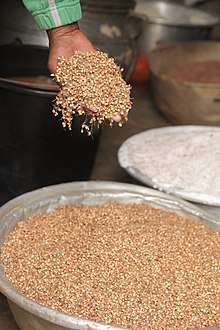sorghum
See also: Sorghum
English
Sorghum

Sorghum grains
Etymology
From New Latin genus name Sorghum, from Italian sorgo, from Vulgar Latin *syricum (“Syrian”), from Sȳricus.
Pronunciation
- IPA(key): /ˈsɔ(ɹ).ɡəm/
Noun
sorghum (countable and uncountable, plural sorghums)
- A cereal, Sorghum bicolor (syn. Sorghum vulgare) the grains of which are used to make flour and as cattle feed.
- 1936, Harry Nelson Vinall, Joseph Charlworth Stephens, John Holmes Martin, Identification, History, and Distribution of Common Sorghum Varieties, US Department of Agriculture, Technical Bulletin No. 506, page 2,
- The sorghum crop has four uses — forage, grain, sirup, and industrial (such as the manufacture of brooms, wallboard, etc.).
- 1978, US Department of Agriculture, Watch out for witchweed, a serious pest of corn, sorghum, and other crops, Animal and Plant Health Inspection Service, Program Number 1212, unnumbered page,
- Witchweed (Striga spp.) is a parasitic plant that attacks corn, sorghum, sugarcane, rice, and more than 60 different species of the grass family.
- 2008, Lamissa Diakité, Amadou Sidibé, Melinda Smale, Mikkel Grum, Seed Value Chains for Sorghum and Millet in Mali: A State-based System in Transition, International Food Policy Research Institute, Discussion Paper 00749, page 2,
- Archaeological evidence suggests that economies based on cattle, goats, sorghum, and pearl millet were established in this region between 5,000 and 3,000 years ago (Smith 1998).
- 1936, Harry Nelson Vinall, Joseph Charlworth Stephens, John Holmes Martin, Identification, History, and Distribution of Common Sorghum Varieties, US Department of Agriculture, Technical Bulletin No. 506, page 2,
- (Southern US) Sorghum syrup.
Synonyms
- (cereal): guinea corn (West Africa); Kafir corn (South Africa); mtama (East Africa); durra (Sudan); juar, jowar, cholam (India); kaoliang (China); milo (United States)
Coordinate terms
Derived terms
Related terms
Translations
cereal
|
|
This article is issued from
Wiktionary.
The text is licensed under Creative
Commons - Attribution - Sharealike.
Additional terms may apply for the media files.